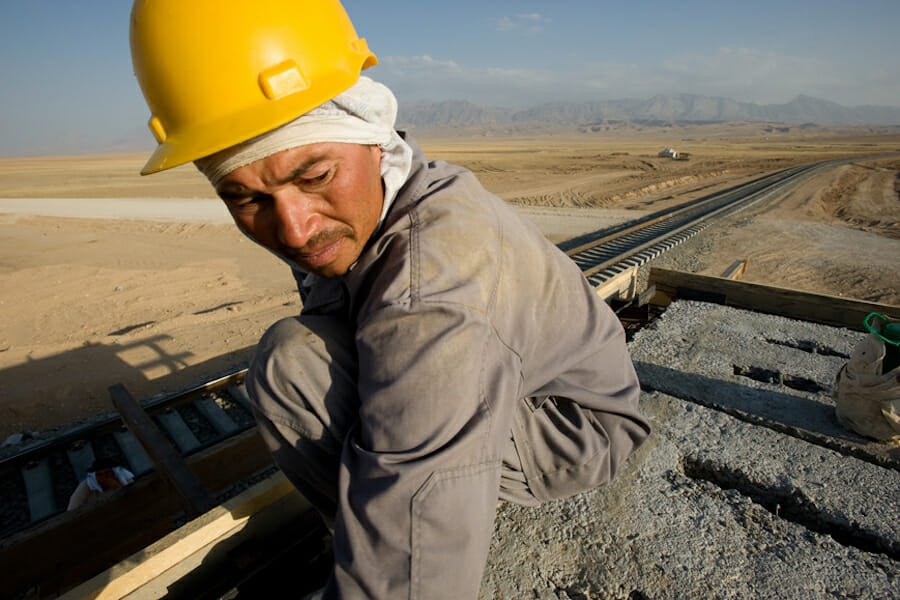
Damned by Riches: How Afghanistan’s Mineral Wealth Undermines NATO Mission
It is like something out of a movie: deep in the archives of a war-torn country a team of intrepid scientists discovers forgotten maps leading to buried treasure. Fantastical as it seems, such a scene played out in 2004 when American geologists found a cache of charts in the Afghan Geological Survey’s library dating from the days of Soviet occupation. Returned to the library after the NATO invasion, these Russian charts were protected in geologists’ homes through the tumultuous 1990s’ and for good reason: the data indicated under Afghanistan’s mountains and dry plains lay vast mineral deposits.
Guided by Soviet charts, aerial surveys in 2006 and 2007 covered 70% of the county and produced the most comprehensive geologic study in Afghan history and estimate the nation’s untapped mineral wealth at $1 trillion. Today the Afghan government believes this wealth buried in their rugged provinces could exceed $3 trillion, but as frequently asked of buried treasure: is it cursed?
Afghanistan’s mineral resources are hard to underestimate and current projections border on the hyperbolic. In June 2010, the Pentagon confirmed reports that Afghanistan’s massive deposits could make it a major world producer of iron and copper. The lithium deposits in Ghazni Province may rival Bolivia’s for the title of world’s largest. The country’s Samti gold deposit is estimated to hold 20-24 metric tons and according to the US Geological Survey, a single million-ton deposit of rare earth elements (REE) in Helmand Province gives Afghanistan the world’s sixth largest REE reserves.
All this has caught the attention of the region’s major economies. Already Indian corporations have secured rights to most of Hajigak’s 1.8 billion metric tons of iron. Having bought a 30-year lease for $3 billion, China Metallurgical Group now operates a copper mine at Mes Aynak on what used to be an Al Qaeda training camp.
Moreover, as China produces 95% of the world’s REEs, Afghanistan will benefit from the global economy’s growing need for these metals which are used in everything from fuel additives to jet engines, smartphones to cancer treatments. There is little doubt this potential wealth will transform Afghan lives, but whether it raises generations out of poverty or plunges them into exploitation and civil war is the immediate question.
“I wish we had discovered water.” The words of former Saudi oil minister Sheikh Ahmad Yamani offer a sober reminder that, like so many resource-rich countries, Afghanistan’s potential wealth could detrimentally and irrevocably change this fragile state. Landlocked, underdeveloped, undereducated, ethnically fractious, insanely rich and surrounded by powerful neighbors Afghanistan is a prime candidate for the resource curse, that paradox wherein resource-rich countries at best suffer poor development and economic growth and at worst are torn apart by brutal governments and civil war.
Considering Afghanistan’s social infrastructure, ethnic tensions, and rampant corruption it seems inevitable that they will fall victim to the resource curse as they have already taken their first steps down that precipitous path. China’s bribe-tainted acquirement of the Aynak copper mine is expected to bring in $1 billion in annual government revenues and according to Craif Steffensen, Afghanistan country director for Asian Development Bank, the Hajigak iron ore deposit is estimated to bring in up to $3 billion in government revenues for centuries.
Should Afghanistan develop its mining potential these are just two of the many pipelines that will gush money into the government’s coffers, and with such wealth come very real risks. With natural resources guaranteeing a secure national income, governments are no longer reliant on their citizen’s tax money or public approval and this frequently leads to corruption, misappropriation, and embezzlement with devastating social consequences.
A typical case of such governmental abuse is Angola, the world’s 7th largest oil producer, and 5th largest diamond producer, where 77.4% of its population lives in poverty and roughly half of the country’s 18 million people survive on less than $1.25 per day. However, the Confederation of African Football estimates the Angolan government spent $1 billion to host 2010’s African Cup of Nations soccer tournament and this is not atypical of oil wealth appropriation. More government money is wasted on projects such as the recent building of 24 new hospitals without physicians to staff them or buying 3,000 new buses with only 1,500 available drivers.
However inept these expenditures they cannot compare to the outright theft which has turned Angola into an unabashed kleptocracy. From 1996-2001 over $1 billion a year went missing and in 2002 NGO Global Witness found $1.1 billion of Angolan oil revenue held in a single private bank account in the British Virgin Islands. Recently the International Monetary Fund reported $32 billion of public funds disappeared from 2007-2010, close to one-third of national revenues. Angola is a grim example of what may be Afghanistan’s future, but certainly not the darkest.
September 11th, 2001: In the United States 2,977 people were killed in an Al Qaeda attack, in Afghanistan the perpetrators cheered, and in the Democratic Republic of Congo (DRC) it was just another day of genocidal slaughter. The Second Congo War is not well known but from 1998-2003 it directly involved eight African nations and some 25 armed groups, earning the distinction of the world’s bloodiest conflict since WW2. Mineral wealth like Afghanistan’s was one of the conflict’s chief motivators which resulted in 5.4 million war and postwar deaths.
Today this mineral wealth defines Congolese lives as the world’s manufacturers demand more cassiterite, wolframite, coltan, and gold to produce more laptops, smartphones, and hybrid vehicles. With such immediate wealth, lines of law and order blur until little distinguishes kleptocratic government forces from brutal rebel militias. Both fight to control the lucrative mines. Both illegal tax, extort and force local adults and children to work the mines in shifts lasting as long as 48 hours. Both rebel militias and the Congolese National Army use rape and violence to ensure the flow of minerals.
While exact numbers are impossible to come by it is estimated that just cassiterite, refined as tin and used to solder circuit boards, earns rebel groups $85 million a year and these revenues can buy arms and prolong conflicts indefinitely, especially when an AK-47 costs a modest $50 in the DRC. A weak central government, rampant corruption, deep ethnic divisions coupled with immense mineral wealth and the ready supply of weapons are some of the similarities which indicate that the DRC’s present could easily be Afghanistan’s future. After all, according to the World Bank the going price for an AK-47 in Kabul is only $150 and with an average mechanical lifespan of up to 40 years, it is a cost-effective weapon for prolonged resource conflicts.
While Afghanistan’s fate is far from preordained, it is difficult to overstate how precarious its situation is. Their mineral resources could generate immense wealth and bring generations out of poverty, but the arc of history is bending towards a darker future. Two years before the total withdrawal of American combat forces rival political factions such as the non-Pashtun National Front for Afghanistan (NFA) hope to restructure the government as a parliamentary democracy to break the Pashtun majority’s hold on power. President Hamid Karzai, a Pashtun, hopes for political reconciliation with the ethnic-Pashtun Taliban to shore-up his power base but cannot afford to alienate the anti-Taliban NFA.
For their part, the Taliban show little interest in President Karzai as they attempt to cut him out of ongoing peace negotiations with the US government and believe the NFA’s policies are a drive to partition the country under the mask of devolved federalism. A dark but not unrealistic possibility is Karzai would seek a peace deal at the expense of the NFA, the non-Pashtuns revolt against the Karzai/Taliban bloc, and in due course the Taliban turn on both Karzai and the NFA. The nation’s half million soldiers and police would split down ethnic lines and the country spiral out of control into civil war. Afghanistan’s mineral wealth is widely distributed throughout the country and artisanal small-scale mines could turn the country into a lawless conflict zone for generations.
In this volatile situation, the man most capable to either pull his country back from the ledge or throw it headlong into the abyss is Hamid Karzai and his record as president leaves little optimism Afghanistan will escape the resource curse. According to Transparency International, Afghanistan is the 4th most corrupt country in the world. This is corroborated by UN findings that Afghan families pay $160 in bribes to police, judges, and government officials per year; a high price in a country where the per capita GNI is $410. In 2009 bribes made up almost 25% of Afghanistan’s $2.5 billion GDP, making bribery and the drug trade the country’s leading sources of income. And corruption is by no means confined to the local level.
Prominent officials and Karzai’s own brother were implicated in the Kabul Bank scandal that cost the national government and western donors $900 million. NATO investigators uncovered evidence in 2009 that Afghan soldiers routinely died from infections and lack of treatment because they could not afford to bribe doctors and nurses. The culture of bribery has embedded itself in Afghanistan’s newly discovered mineral wealth as the minister of mines accepted a roughly $30 million bribe for awarding the Aynak copper deposits to the China Metallurgical Group. Penalties are not an issue as President Karzai’s government has not yet prosecuted a single high-level corruption case. Perhaps the words of Anthony H. Cordesman, a defense expert for the Center for Strategic and International Studies, said it best: “If you find people who aren’t corrupt it is largely because they haven’t had the opportunity.”
While the present does not equal the future, it is unlikely Afghanistan will escape the resource curse. Its national government is thoroughly corrupt, holds little sway outside the capital, and though Karzai has said he will retire in 2014 Afghans widely believe he will remain in power unofficially or extra-constitutionally. Afghanistan’s population has deep ethnic and tribal divides which continually threaten national unity and could easily devolve into civil war.
Additionally, the Taliban remains a threat to fragile national governments in both Afghanistan and neighboring Pakistan. According to a UN Security Council report the country is awash in more than a million small arms and many of these in the hands of the Afghan Local Police (ALP), US-backed militias ostensibly formed to fight the Taliban. A recent Human Rights Watch report documents that in addition to land grabs and illegal taxation these militias have terrorized civilians with abduction, rape, torture, and murder. Currently some 19,000 strong, the ALP is expected to grow to 30,000 by the time the NATO mission ends in 2014.
Already the resource curse can be observed in Khost Province where chromite is illegally excavated in small artisanal mines and smuggled across the porous Pakistani border costing Kabul $7.3 million a year in lost revenues, enriching organized crime, and arming insurgent groups. Though the country does not have to descend into generational civil war underwritten by a million mine holes, the evidence suggests that with the NATO withdrawal insight it may be time to prepare for the worst.
Whether the country collectively prospers from its wealth or unravels before the world’s eyes into bloody chaos will depend more on Karzai’s corrupt government and major mineral buyers (India, Iran, China) than those nations who tried to plant western ideals in the graveyard of empires.

